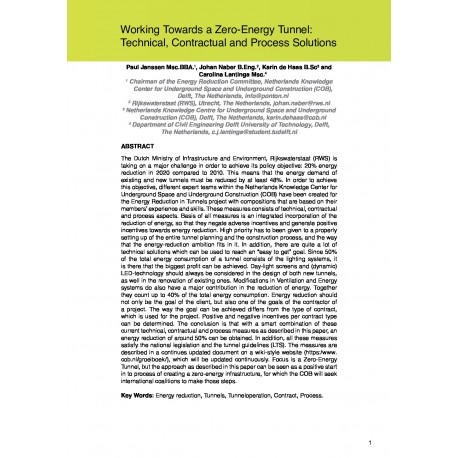Cart
0
0
No document
0,00 €
Total
Document successfully added to your shopping cart
Quantity
Total
There are 0 items in your cart.
There is 1 item in your cart.
Total documents
Total shipping
To be determined
Total
Search & filter
Search for a publication
Search & filter

Working Towards a Zero-Energy Tunnel: Technical, Contractual and Process Solutions
1306_working_towards_a_zero_ener
K. De Haas / P. Janssen / J. Naber / C. Lantinga
The Dutch Ministry of Infrastructure and Environment, Rijkswaterstaat (RWS) is taking on a major challenge in order to achieve its policy objective: 20% energy reduction in 2020 compared to 2010. This means that the energy demand of existing and new tunnels must be reduced by at least 48%. In order to achieve this objective, different expert teams within the Netherlands Knowledge Center for Underground Space and Underground Construction (COB) have been created for the Energy Reduction in Tunnels project with compositions that are based on their members’ experience and skills. These measures consists of technical, contractual and process aspects. Basis of all measures is an integrated incorporation of the reduction of energy, so that they negate adverse incentives and generate positive incentives towards energy reduction. High priority has to been given to a properly setting up of the entire tunnel planning and the construction process, and the way that the energy-reduction ambition fits in it. In addition, there are quite a lot of technical solutions which can be used to reach an “easy to get” goal. Since 50% of the total energy consumption of a tunnel consists of the lighting systems, it is there that the biggest profit can be achieved. Day-light screens and (dynamic) LED-technology should always be considered in the design of both new tunnels, as well in the renovation of existing ones. Modifications in Ventilation and Energy systems do also have a major contribution in the reduction of energy. Together they count up to 40% of the total energy consumption. Energy reduction should not only be the goal of the client, but also one of the goals of the contractor of a project. The way the goal can be achieved differs from the type of contract, which is used for the project. Positive and negative incentives per contract type can be determined. The conclusion is that with a smart combination of these current technical, contractual and process measures as described in this paper, an energy reduction of around 50% can be obtained. In addition, all these measures satisfy the national legislation and the tunnel guidelines (LTS). The measures are described in a continues updated document on a wiki-style website (https:/www.cob.nl/groeiboek/), which will be updated continuously. Focus is a Zero-Energy Tunnel, but the approach as described in this paper can be seen as a positive start in to process of creating a zero-energy infrastructure, for which the COB will seek international coalitions to make those steps. Energy reduction, Tunnels, Tunneloperation, Contract, Process.


